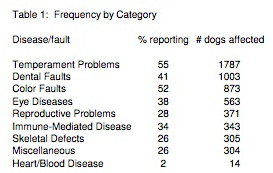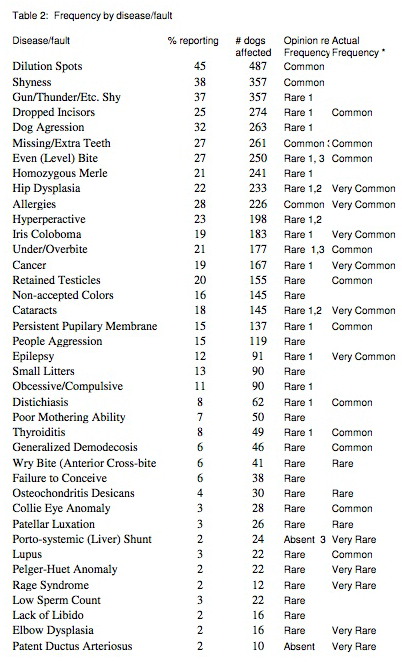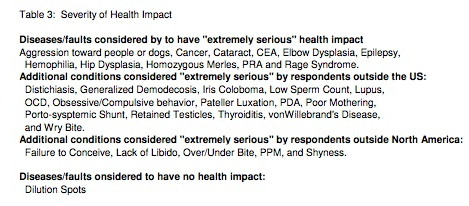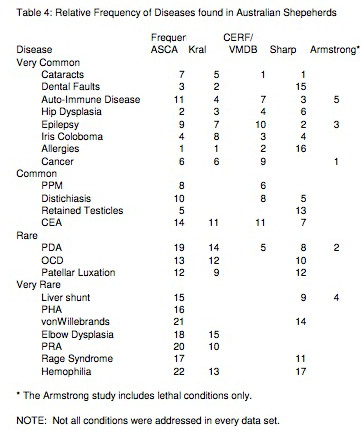by C.A. Sharp and Peter Adolphson on behalf of the ASCA DNA & Genetics Committee
First printed in the Aussie Times, Jan-Feb 2002
.
In the last half of 1999, the Australian Shepherd Club of America conducted its first ever breed health survey. The survey form was published in three consecutive issues of the Aussie Times as well as being made available on the club’s website. It was open to any Aussie owner, without regard to ASCA membership.
The following is an analysis of the over-all data set. We hope in the future to take a more detailed look at sub-sets of the data (breeders vs. non-breeders, breakdown by ASCA regions, etc.) if time permits.
This type of survey cannot provide hard data on specific genetic diseases or inherited faults in the breed. No veterinary documentation of diseases can be provided and respondents are those who feel personally motivated to respond, either through a feeling of duty to the breed or a need to express concern about something that has affected them or their dogs. However, the survey can and does give us an idea of how knowledgeable people are about various conditions and faults and about their experiences with them. It also indicates the relative frequency of problems in the breed. Some results were expected (we knew cataracts were a major problem); others were a surprise (we didn’t expect the number of reports on retained testicles).
Who Responded
Most respondents, if not breeders, were significantly involved in activities or work with their dogs. This was expected. Those with the most personal investment in their dogs are the ones who will be motivated to respond to a survey of this kind.
There were 345 total responses received, 85% of which were from those who stated they were ASCA members. This represents about 4.5% of ASCA’s total membership. 83.7% of the respondents were in the US, 9.6% in Canada and the balance in Europe or Australia. Nearly all of the US respondents were ASCA members, as were slightly over a third of the Canadian respondents. Less than 1% of the European/Australian respondents claimed ASCA membership, which probably reflects the fact that other canine organizations are responsible for the local registry and breed matters in those countries (other than Germany, which utilizes ASCA’s registry.)
When responses are compared to actual ASCA member/location statistics for members outside the US, responses were received from nearly half of the European/Australian members and one in 8 Canadian members. This greatly exceeds rate of US member response of fewer than one in 20. The scope of our survey does not allow us to determine whether this reflects greater apathy on the part of US members or that more of them are only peripherally involved in the breed (i.e. have a pet and decided to join, but don’t breed or participate in club programs.) It will be interesting to observe whether the new membership scheme that will be instituted January 1, 2002 leads to different response patterns in any future survey, as persons interested only in subscribing to the Times will no longer have to join and those only interested in utilizing the registry will be non-voting “service” members..
For every respondent that indicated being a breeder or the owner of breeding dogs, there were two who were not. Outside the US, ¾ of respondents were breeders/owned breeding dogs, which reinforces the supposition that low US response may have been at least partly due to larger numbers of US members who are not deeply involved in the breed.
Experience in the breed varied from some who had just obtained their first Aussie to one individuals who has had Aussies for 41 years. The average involvement in the breed was 11 years (8 in Canada), indicating a high level of breed commitment on the part of respondents. Outside North America the average was 6, no doubt reflecting the Aussie’s “new breed” status in those regions.
Respondents owned, on average, 4 adult Aussies, one pup and one dog of another breed. The US and Canada were identical in this regard. European/Australian respondents were more likely to have slightly fewer adult Aussies and one more other-breed dog.
Roughly 65% of respondents stated they participated in conformation and/or obedience, 40% in Agility and 30% in stockdog trials. 10% had a commercial agricultural operation in which they used their dogs. Fully 35% were involved in dog-related activities, most often flyball, pet therapy, or tracking. Only two respondents mentioned club work, but that may be because club activity is so integral to intense involvement in dogs that respondents considered it a “given” and didn’t think it required special notation. (This includes the Committee, as when we designed the form we didn’t make a separate listing for it.)
The level of dog-related activities in which the respondents take part indicates that they are perhaps more motivated than the “average dog owner” and therefore probably more proactive on health and other issues. In short, the people who responded are those most likely to make a positive difference in matters of breed health.
Health Issues
Two types of questions regarding health/genetic fault issues were asked. One requested the respondent’s opinion of the severity or frequency of a particular problem. The intention was to gauge knowledge levels and indicate areas of concern, which will help ASCA and its DNA & Genetics Committee pinpoint educational needs. The second question asked how many dogs/litters respondents had produced or owned with each problem.
It is acknowledged that the responses to these questions were the opinions of the individuals making them. Several individuals criticized the survey in the “comment” section or during in on-line discussions, for soliciting opinion rather than gathering hard data. However, knowing what people think—be it right or wrong—is important to setting goals and making decisions in our battle with hereditary disease. And, as noted previously, one cannot get “hard data” from this type of survey.
 In terms of numbers of affected dogs reported, temperament problems were the most frequent. Heart/blood diseases were the least-reported category (see Table 1). All categories, except the heart/blood diseases, were experienced by at least a quarter of the individuals responding. This may be due to a tendency for those who have experienced problems to respond, but the percentage of respondents appears too high to be explained by this alone.Temperament is a blend of nature and nurture. With the exception of Rage Syndrome, which is a neurological disorder, all the listed problems can be induced or exacerbated by environmental factors. Inexperienced owners may misinterpret the Aussie’s natural high-energy character as “hyperactive” or “obsessive/compulsive.” It will be interesting to see if temperament problems are viewed differently by owners vs. breeders and by those long-experienced with the breed vs. breed novices when future, more detailed, analysis of the data is made. We do feel that the strong response to these items indicates a need for the club, breeders and others who are experienced in this breed to do more to educate the public about what kind of dog the Aussie, what kind of training and socialization is necessary, and why certain kinds of homes or situations may be inappropriate.
In terms of numbers of affected dogs reported, temperament problems were the most frequent. Heart/blood diseases were the least-reported category (see Table 1). All categories, except the heart/blood diseases, were experienced by at least a quarter of the individuals responding. This may be due to a tendency for those who have experienced problems to respond, but the percentage of respondents appears too high to be explained by this alone.Temperament is a blend of nature and nurture. With the exception of Rage Syndrome, which is a neurological disorder, all the listed problems can be induced or exacerbated by environmental factors. Inexperienced owners may misinterpret the Aussie’s natural high-energy character as “hyperactive” or “obsessive/compulsive.” It will be interesting to see if temperament problems are viewed differently by owners vs. breeders and by those long-experienced with the breed vs. breed novices when future, more detailed, analysis of the data is made. We do feel that the strong response to these items indicates a need for the club, breeders and others who are experienced in this breed to do more to educate the public about what kind of dog the Aussie, what kind of training and socialization is necessary, and why certain kinds of homes or situations may be inappropriate.
Dental and color faults were the next two most frequently reported, possibly because these things are readily distinguished even by inexperienced individuals, where the others require considerable knowledge or veterinary expertise to identify. Certainly the reproductive issues need to be examined more closely in subsequent reviews of the data, excluding those respondents who do not have breeding animals as the significance of these may be greater than it appears in the overall analysis.
Table 2 contains a similar view of specific diseases/faults, all of which have been reported in Australian Shepherds. Eight of the 42 listed items had been experienced by at least a quarter of the 345 respondents, though only one of these (allergies) is a disease. The remainder were temperament, bite and color issues as discussed above.There were another 14 problems which had been experience by between 10 and 25% of respondents. These included 9 which are diseases or genetic defects. The appearance of low reporting levels may be an artifact of the need for experience or professional evaluation to identify these conditions. It’s easy to detect even minor faults in dentition or color, so large numbers of respondents having recognized them in their dogs is not surprising. However, the fact that more than one respondent in 10 has experienced one or more genetic diseases in their dogs is sobering.
 Responses to the question asking how common respondents felt a particular thing to be were assigned numerical values of 0 through 4, with 0 being “Absent” and 4 “Very Common.” Means (averages) were established for each and then converted to the category for which the numerical value most closely matched the mean. For example, something with a mean of 2.9 it was “Common,” whereas a mean of 1.4 would have been “Rare.” Overall, respondents felt almost all problems to be “rare” and a few to be “absent,” which does not reflect reality or the fact that significant percentages of them had experienced problems in their own dogs. Only four problems were considered “common,” and of these only allergies is a disease. For reasons that will be explained more fully below, we feel this is an unrealistically optimistic view of breed health. As a single example: Cataracts are the most frequently reported breed health problem (based on a compilation of statistics from several different sources named below) and almost one in five respondents reported having one or more dogs with cataracts, yet as a whole they considered the diseases “rare.”
Responses to the question asking how common respondents felt a particular thing to be were assigned numerical values of 0 through 4, with 0 being “Absent” and 4 “Very Common.” Means (averages) were established for each and then converted to the category for which the numerical value most closely matched the mean. For example, something with a mean of 2.9 it was “Common,” whereas a mean of 1.4 would have been “Rare.” Overall, respondents felt almost all problems to be “rare” and a few to be “absent,” which does not reflect reality or the fact that significant percentages of them had experienced problems in their own dogs. Only four problems were considered “common,” and of these only allergies is a disease. For reasons that will be explained more fully below, we feel this is an unrealistically optimistic view of breed health. As a single example: Cataracts are the most frequently reported breed health problem (based on a compilation of statistics from several different sources named below) and almost one in five respondents reported having one or more dogs with cataracts, yet as a whole they considered the diseases “rare.”
This apparent discrepancy may be attributable to how respondents defined the available selections. We will continue to use cataracts as an example. CERF statistics for 1998-1999 indicate that 4% of Aussies presented had inherited cataracts of the type most commonly seen in the breed (posterior cortical). To the average person, 4% may not seem like much. However it extrapolates into the possibility that at least a third of the breed carries gene(s) for the condition, depending on actual mode of inheritance that is as-yet undetermined in this breed. This is another area where response indicates a need for improved educational effort.
By interesting contrast, Canadian respondents considered a number of items to be “common,” including several of the most frequently occurring diseases (see Table 2). European/Australian respondents felt that cataracts, hip dysplasia and hyperactive behavior were common.
Respondents were asked to rate each item by how serious a health impact each had on the dog. As with the question regarding frequency, responses were assigned numerical values and means established for each.
Most respondents had a fairly accurate assessment of which defects/faults had the greatest impact on health (see Table 3.) Those outside the US listed a number of additional conditions, including several reproductive issues that may have little impact on the health of the affected individual (i.e. infertility), but which could have significant impact on breed health or the over-all health of a kennel or line. This may be reflective of a higher percentage of breeders among respondents from outside the US.All other conditions rated as having “somewhat serious” impact on health. These included such obviously cosmetic things as unacceptable colors and those of negligible or null impact, like dropped incisors or level bites. This was at least partly due to a flaw in survey design that was pointed out to us by several respondents: There should have been a category between “None” and “Somewhat Serious”
As stated earlier, owners and breeders of Aussies may be overly optimistic about the frequency of hereditary diseases in the breed. Author Sharp recently evaluated statistics from several different sources, including this survey; the survey conducted by Leos Kral, PhD of West Georgia State University in 1997; the breed longevity study conducted by John Armstrong, PhD, of the University of Ottawa (1998-2000) with Sharp’s assistance; CERF statistics for 1998-9; the Veterinary Medical Data Base statistics for the same period; and the data Sharp has personally gathered over the past 20 years. She developed a ranking of various conditions found in Aussies by their relative frequency. (See Table 4). Due to the varied and different sources she drew upon, she does not intend this to be a representation of precise frequency relationships, but a continuum in which any given disease may actually be slightly more or less frequent than those of similar ranking. Things at the top of the list are those most likely to be encountered. Those at the bottom are least likely.There were some surprises in the data submitted on affected dogs. Allergies and retained testicles were much more frequently reported than we had expected; Collie Eye Anomaly and Patent Ductus Arteriosus (a heart disease) were reported less frequently. Frequency as reported by survey respondents differed somewhat from Sharp’s combined findings, but are basically similar in that the most frequent things and the rarer things are the same on both lists though ordinal ranking may differ.
“I Don’t Know”
Perhaps one of the more disturbing observations of the data is the frequency with which respondents stated they did not know if a particular disease/fault had a health impact or whether it was/was not common in the breed. This again reinforces the need to do a better job of educating those who own and breed Australian Shepherds from the national club/member level on down to the breeder/buyer level.
Summation
The authors intend to examine subsets of the data gathered more closely and report on this in the future. We feel that we have gathered some very useful information about the status of breed health and the knowledge-level of those who own the breed.
The survey was not without its imperfections, some of which have been mentioned previously. A serious one involved technical difficulties with the on-line version, which limited the ability of some to access it. However, all members received a hard-copy via the Aussie Times. US residents active in the breed who are not ASCA members probably know some who are, so we feel that anyone in the US who wanted to respond could have without too much difficulty. For those outside the US, especially those in Europe/Australia, the technical problems may have limited access for the non-members who make up the majority of the breed owners/breeders in those places.
We would like to see another survey conducted approximately 10 years after the first, with additional surveys at similar intervals thereafter to give us a continuing measure of the genetic health of our breed and of the success of our educational efforts. We recommend that future efforts be planned farther in advance of implementation, so that issues such as the problem with the website version can be identified and corrected beforehand. We also recommend that, rather than using terms such as “Common” or “Somewhat Serious,” which are very much open to individual interpretation, that a number scale from most to least be employed.
Finally, we would like to thank the 345 people who took the time to fill out the survey almost 40% of whom also took the extra time and effort to add comments to their responses. We quite literally could not have done this without you.


